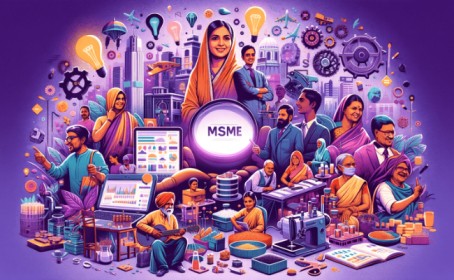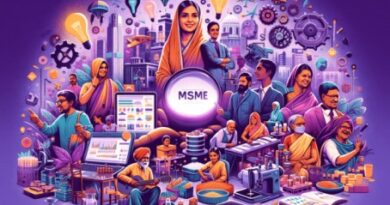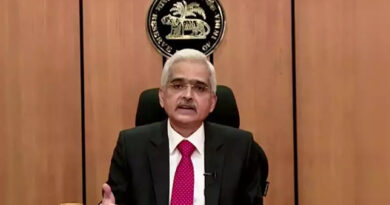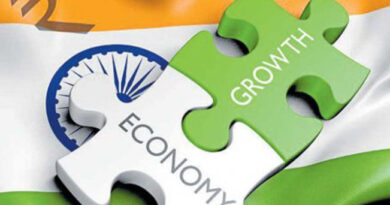MSMEs – The Unsung Heroes of India’s Economic Journey
Micro, Small, and Medium Enterprises (MSMEs) are the lifeblood of India’s economy, contributing significantly to GDP, employment, and exports. Their ability to adapt, innovate, and create opportunities has propelled India towards becoming a global economic powerhouse.
India’s economic journey is a remarkable tale of resilience and growth, intricately woven with the success story of its Micro, Small, and Medium Enterprises (MSMEs). These dynamic entities, fondly referred to as the backbone of the nation’s economy, are not just engines of job creation and innovation, but also champions of inclusive development. From vibrant rural villages to bustling metropolises, MSMEs have become the driving force behind India’s economic miracle. Emerging trends like e-commerce, digital payments, and artificial intelligence offer immense opportunities for MSMEs to innovate and expand their market reach. By embracing these trends and adapting to the changing business landscape, MSMEs can contribute even more significantly to India’s economic transformation.
But what exactly makes MSMEs so crucial, and what challenges and opportunities lie ahead?
This comprehensive analysis delves into the world of MSMEs, exploring their impact, challenges, and future potential, with a special focus on the growing power of women entrepreneurs and the crucial role Indian Bank plays in their success.
MSMEs Powering Progress
The MSME sector in India has witnessed phenomenal growth, steadily expanding its footprint across diverse industries and geographical regions. This exponential rise is a testament to the unwavering entrepreneurial spirit of Indians and the fostering environment created by government policies. Let’s take a look at the numbers:
| Year | Number of MSMEs (in Million) | GDP Contribution (%) |
| 2015 | 51.1 | 25 |
| 2018 | 54.6 | 27 |
| 2021 | 63.4 | 29 |
| 2024 | 75.00 | 30 |
As per the information culled out from the Data Dissemination Portal of Directorate General of Commercial Intelligence and Statistics (DGCIS), the share of export of MSME specified products in all India exports are as follows:
| Year | % share of Export of MSME related products in All India Export |
| 2019-20 | 49.75% |
| 2020-21 | 49.35% |
| 2021-22 | 45.03% |
| 2022-23 | 43.59% |
| 2023-24 | 45.73% |
| 2024-25* | 45.79% |
*up to May 2024
MSMEs are the unsung heroes of India’s economy, contributing significantly to its growth and development. Accordingly, to recognize and support MSMEs on International MSME Day (27th June), 2024, the Ministry of Micro, Small & Medium Enterprises (MSME) organised the ‘Udyami Bharat-MSME Day‘ event and proposed amendment to MSME Development Act, 2006 to improve dispute resolution for delayed payments and address the changing needs of the MSME sector. Further, the government’s target of $1 trillion in exports by 2028 heavily relies on MSME contribution.
Employment Generation: A Beacon of Opportunity
MSMEs have been instrumental in creating employment opportunities across the length and breadth of the country, particularly in rural and semi-urban areas. Their ability to absorb a vast workforce, especially from marginalized sections of society, plays a crucial role in poverty alleviation and inclusive growth. MSMEs are the largest employers in India, providing jobs to over 120 million people, making them the second-largest employment generator after agriculture. Sectors like textiles, food processing, and handicrafts heavily rely on MSMEs for employment.
Challenges Faced by MSMEs:
Despite their remarkable resilience, MSMEs face a multitude of challenges that hinder their growth potential. Further, as per SIDBI MSME Pulse report highlights that only about 16% of MSMEs have access to formal credit.
Here’s a closer look at some key hurdles:
- High-interest rates on formal credit: MSMEs often face exorbitant interest rates when borrowing from banks or financial institutions, reducing their profit margins and hindering growth. For instance, a small-scale manufacturer might be charged interest rates as high as 12-15%, making it difficult to compete with larger firms.
- Complex documentation and collateral requirements: The cumbersome process of obtaining loans, involving extensive paperwork and collateral, acts as a significant barrier for MSMEs. A small retailer might struggle to provide property as collateral, limiting their borrowing capacity.
- Limited access to institutional finance for micro-enterprises: Micro-enterprises, forming the backbone of the MSME sector, often find it challenging to access formal credit due to their small size and informal nature of operations. A street vendor or a small grocery shop owner might rely on moneylenders for capital, often at exorbitant rates.
- Access to Finance: Limited access to credit hampers business expansion and innovation.
- Infrastructure Deficiencies: Poor infrastructure, including electricity and transportation, increases operational costs.
- Market Access: Finding suitable markets for products can be challenging, especially for rural-based MSMEs.
- Technology Adoption: Lack of digital literacy and awareness hinders technology adoption, which is crucial for enhanced productivity and competitiveness.
- Raw Material Costs: Fluctuations in raw material prices impact profitability.
- Skilled Labor Shortage: Availability of skilled manpower is often a challenge, especially in certain sectors.
- Regulatory Compliance: Complex and time-consuming regulatory requirements can be a burden for MSMEs.
- Competition: Increasing competition, both domestic and international, can affect the growth and sustainability of MSMEs.
Empowering MSMEs by Indian Public Sector Banks
Indian Bank, a leading public sector bank, recognizes the pivotal role of MSMEs in propelling India’s economic growth. The gross bank credit deployed to MSMEs under priority sector lending in October 2023 amounted to US$ 279.18 billion, marking a 22.8% increase from the previous year and an 11.8% rise from September 2023, according to the latest RBI data on sectoral deployment. The bank has taken a proactive approach to support MSMEs through a comprehensive suite of financial solutions and initiatives:
- Mudra Loans: Tailored loan schemes under the Pradhan Mantri Mudra Yojana (PMMY) cater to micro and small enterprises, providing collateral-free loans to empower them to start and grow their businesses. Under Pradhan Mantri Mudra Yojana (PMMY), In FY24, In FY24, Rs. 5.41 lakh crore (US$ 64.87 billion) was sanctioned under 6.6 crore Mudra loans to non-corporate and non-farm MSEs.
- Stand-Up India Loans: This dedicated scheme offers loans to women and SC/ST entrepreneurs, fostering inclusive growth and promoting women’s entrepreneurship and facilitate bank loans between Rs. 10 lakh and Rs. 100 lakh.
- Credit Guarantee Fund Trust for Micro and Small Enterprises (CGTMSE): Collateral free loan up to a limit of Rs. 500 lakh (w.e.f. 01.04.2023) to MSEs (Micro Small Enterprises) with guarantee coverage up to 85% for various categories of loan through Credit Guarantee Fund Trust for Micro and Small Enterprises (CGTMSE) under Credit Guarantee Scheme.
- Subsidised Interest Rates: Competitive interest rates on loans make financing more accessible and affordable for MSMEs.
- Flexible Repayment Options: Understanding the dynamic cash flow needs of MSMEs, Indian Bank offers flexible repayment schemes to ease the financial burden.
- Financial Literacy Programs: The bank conducts workshops and seminars to educate MSMEs on financial management, loan options, and digital banking solutions.
- Dedicated Relationship Managers: Indian Bank assigns experienced relationship managers to MSMEs, providing personalized guidance and support throughout their growth journey.
Government Initiatives
- Pradhan Mantri Mudra Yojana (PMMY): This scheme has been instrumental in providing collateral-free loans to MSMEs, especially in the micro-enterprise sector and loan upto Rs. 10.00 Lakhs can be granted. For example, a small tea stall owner can avail of a Mudra loan to purchase additional equipment or expand the seating area.
- Stand-Up India Scheme: Specifically targeting women and SC/ST entrepreneurs, this scheme offers loans for setting up new enterprises. A woman entrepreneur looking to start a small manufacturing unit can benefit from this scheme.
- Credit Guarantee Fund Trust for Micro and Small Enterprises (CGTMSE): Collateral free loan up to a limit of Rs. 500 lakh (w.e.f. 01.04.2023) to MSEs (Micro Small Enterprises) with guarantee coverage up to 85% for various categories of loan through Credit Guarantee Fund Trust for Micro and Small Enterprises (CGTMSE) under Credit Guarantee Scheme. By providing guarantees to banks, this scheme encourages lending to MSMEs, reducing the risk for lenders. A small-scale manufacturer can avail of a loan with the CGTMSE guarantee, even with limited collateral.
- Government e-Marketplace (GeM): This online platform facilitates public procurement from MSMEs, providing them with access to a wider market.
- CHAMPIONS Portal: It is an ICT-driven Control Room and Management Information System focused on enhancing output and national strength through modern processes. It aims to help Indian MSMEs become National and Global CHAMPIONS by addressing their issues and providing guidance, support, and assistance along the way.
- MSME Samadhaan Portal: Launched to address delayed payments, a chronic issue for small businesses.
- Recognizing the sector’s importance, the Indian government has launched several initiatives to support MSMEs. The ‘Make in India’ campaign, for example, has given a significant boost to manufacturing MSMEs by encouraging domestic production and improving ease of doing business.
- Another game-changing initiative is the Emergency Credit Line Guarantee Scheme (ECLGS), introduced during the COVID-19 pandemic. This scheme provided much-needed liquidity to MSMEs, helping them weather the economic storm. As of March 2023, over 1.19 crore MSMEs had benefited from this scheme, with sanctions exceeding ₹3.2 lakh crore.
- The government’s focus on ‘Vocal for Local’ and ‘Atmanirbhar Bharat’ initiatives has given a significant boost to the MSME sector,” notes a report from Invest India.
- Innovative solutions are emerging. For example, the Trade Receivables Discounting System (TReDS) platform is revolutionizing MSME financing. This digital platform allows MSMEs to auction their trade receivables to multiple financiers, ensuring quicker access to working capital.
- 50,000 crore equity infusion through Self Reliant India Fund. This scheme has a provision for corpus of Rs.10,000 crore from Government of India.
- Under Vivad se Vishwas – Relief by way of refund of 95% of the deducted performance security, bid security and liquidated damages was provided to MSMEs. Relief was also provided to MSMEs debarred for default in execution of contracts.
- Registration of MSMEs through ”Udyam Registration Portal” for Ease of Doing Business.
- No global tenders for procurement up to Rs. 200 crore.
- Inclusion of retail and wholesale trades as MSMEs w.e.f. 02.07.2021.
- Non-tax benefits extended for 3 years in case of an upward change in status of MSMEs.
- Roll out of Raising and Accelerating MSME Performance (RAMP) programme with an outlay of Rs. 6,000 crore over 5 years.
- Integration of Udyam Registration Portal with National Career Service (NCS) of Ministry of Labour& Employment and Skill India Digital of Ministry of Skill Development and Entrepreneurship. Registered MSMEs are enabled to reach out to trained manpower and capacity building.
- Launch of Udyam Assist Platform (UAP) to bring the Informal Micro Enterprises (IMEs) under the formal ambit for availing the benefit under Priority Sector Lending (PSL).
- Launch of ‘PM Vishwakarma’ Scheme on 17.09.2023 to provide end to end holistic benefits to the traditional artisans and craftspeople engaged in 18 trades.
- In the interim budget 2024-2025, it was announced the establishment of a corpus totalling Rs. 1 lakh crore (US$ 11.99 billion), offering 50-year interest-free loans. This initiative aims to incentivize the private sector, particularly MSMEs, to enhance research and innovation in emerging sunrise domains.
- Interim Budget 2024 allocates Rs. 22,137.95 crores (US$ 2.65 billion) for MSMEs, emphasizing new clusters and technology centres for global competitiveness, with positive feedback from industry stakeholders.
The Udyam Registration Portal was launched on 01.07.2020 to facilitate ease of registration for MSMEs and access to all the Schemes and benefits. The registration process is free of cost, paperless and digital. As on 05.02.2024, more than 3.64 crore MSMEs with an employment of more than 16.86 crore, have registered on Udyam Portal (this includes the Informal Micro Enterprises (IMEs) registered on Udyam Assist Platform (UAP)).
Success Story:
Chhagan Bhujbal Shetkari Stree Shakti Sanghatna
This women’s self-help group in Maharashtra has successfully transformed the lives of rural women through agriculture and allied activities. By providing access to finance, training, and markets, the group has empowered women to become entrepreneurs and contribute to their community’s development.
Ludhiana’s Auto Parts Cluster
The thriving auto components cluster in Ludhiana, Punjab exemplifies the MSME sector’s economic impact. Hundreds of small manufacturers form a robust supply chain, producing everything from nuts and bolts to complex engine parts for both domestic and international markets.
Amul: A dairy cooperative that has transformed the lives of millions of milk producers.
Bajaj Auto: Started as a small workshop and has evolved into a global automotive giant.
Patanjali: A successful FMCG company focusing on natural and Ayurvedic products.
Liva Fluid Technologies: A Hyderabad-based MSME that developed a world-class engine oil additive.
Take, for instance, the bustling textile hub of Tirupur in Tamil Nadu. This small city is home to thousands of MSMEs that collectively export garments worth billions of dollars annually. From small family-run workshops to medium-sized factories, these enterprises showcase the sector’s ability to drive economic growth and create employment opportunities.
The Road Ahead
The MSME sector holds immense potential for driving India’s economic growth. By addressing challenges, leveraging technology, and promoting entrepreneurship, India can unlock the full potential of MSMEs.
- Government Support: Continued government support through policies, infrastructure development, and financial incentives is crucial.
- Skill Development: Investing in skill development programs can enhance the capabilities of MSME workforce.
- Technology Adoption: Encouraging digital adoption can improve efficiency and market reach. Indian Micro, Small and Medium Enterprises (MSMEs) are rapidly adopting digital payments over cash, with 72% payments done through the digital mode compared with 28% cash transactions. Rise in digital adoption presents prospects for further growth in the sector. In FY23 till December 31, 2022, the number of digital transactions stood at 9,192 crore and worth Rs. 2,050 trillion (US$ 24.73 trillion) as per Indian Brand Equity Foundation.
- Mentorship and Networking: Providing mentorship and networking opportunities can foster growth and innovation.
- Financial Inclusion: Expanding access to finance through various channels can empower MSMEs.
- Success Stories: Highlight exemplary MSMEs that have overcome challenges and achieved significant growth.
- Industry-Specific Case Studies: Explore case studies from specific sectors like agriculture, manufacturing, or services.
- Regional Focus: Analyze the MSME ecosystem in a particular region (e.g., North India, South India) and identify challenges and opportunities.
Future Outlook
- Impact of Technology: Discuss the role of technology in transforming the MSME landscape, including AI, IoT, and blockchain.
- Global Trends: Analyze global trends affecting MSMEs and their implications for India.
- Sustainability: Explore the importance of sustainability for MSMEs and potential business models.
Growth Opportunities:
The MSME sector is not just about traditional manufacturing. New opportunities are emerging in sectors like e-commerce, renewable energy, and biotechnology. The rise of the digital economy has opened up new avenues for MSMEs to reach global markets.
- Consider the success story of Vahdam Teas, an MSME that leveraged e-commerce to become a global brand. Starting as a small tea exporter, Vahdam now sells premium Indian teas directly to consumers in over 100 countries, showcasing the potential of digital platforms for MSME growth.
- “The next wave of growth for Indian MSMEs will come from their integration into global value chains,” predicts an IBEF industry report.
Conclusion
- MSMEs are the unsung heroes of India’s economic journey.
- Their unwavering spirit, resilience, and entrepreneurial acumen have propelled the nation towards becoming a global economic powerhouse and instrumental in the nation’s progress.
- By creating a supportive ecosystem, addressing challenges, and leveraging the potential of women entrepreneurs, India can harness the full potential of its MSME sector and build a more prosperous and inclusive future.
- By addressing the challenges faced by MSMEs and providing a conducive environment, India can harness the full potential of this sector and create a more inclusive and prosperous future for all.




